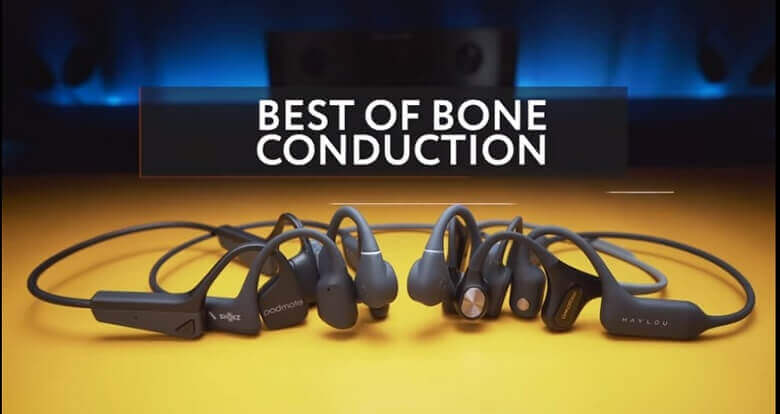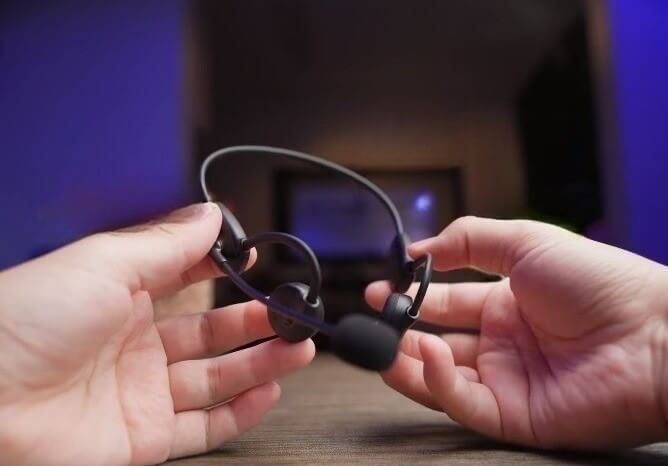Budget Bone Conduction Headphones refer to a category of affordable headphones that use bone conduction technology to transmit sound through vibrations, bypassing the eardrums and directly stimulating the inner ear.
These cost-effective options provide users with the benefits of bone conduction technology, such as increased situational awareness and comfort, without the high price tag often associated with premium models.
While they may not have the same level of performance as their more expensive counterparts, budget bone conduction headphones still offer decent sound quality and features for a satisfying listening experience.

*** TABLE OF CONTENTS ***
Why Budget Bone Conduction Headphones?
Bone conduction headphones have been gaining popularity among fitness enthusiasts, tech-savvy individuals, and music lovers alike.
This innovative technology allows users to enjoy their favorite tunes without compromising the ability to hear their surroundings, making them perfect for outdoor activities like running or cycling.
However, high-quality bone conduction headphones can be quite pricey.
Luckily, there are budget options available that still deliver excellent performance.
In this guide, we will explore budget bone conduction headphones and recommend the top 5 models currently on the market.
How Do They Work?
Bone conduction headphones work by transmitting sound waves through vibrations directly to the inner ear, bypassing the eardrums.
This is achieved by placing the headphones on your cheekbones or jawbone, rather than inside your ears.
These vibrations are then interpreted by the cochlea as sound, allowing you to hear music, podcasts, or calls without blocking your ears.
Benefits
Bone conduction headphones offer several advantages compared to traditional headphones:
- Situational awareness: Since your ears remain open, you can still hear ambient noises, making them safer for outdoor activities.
- Comfort: No earbuds or over-ear cups mean less irritation and discomfort during prolonged use.
- Accessibility: They can be used by individuals with hearing impairments or those who cannot wear in-ear or over-ear headphones.
Who are Budget Bone Conduction Headphones for?
Budget bone conduction headphones are a great option for various users who want to enjoy the benefits of bone conduction technology without spending a fortune.
They can be ideal for:
- Fitness enthusiasts: Individuals who enjoy running, cycling, or working out may find budget bone conduction headphones helpful for staying aware of their surroundings while listening to music or podcasts.
- Commuters: People who travel to work or school regularly can benefit from the increased situational awareness provided by bone conduction headphones, making their daily commute safer and more enjoyable.
- Hearing-impaired individuals: Bone conduction technology can be a valuable tool for those with hearing impairments, as it bypasses the eardrum and directly stimulates the inner ear, enabling them to hear sounds more effectively.
- Outdoor adventurers: Budget bone conduction headphones can be a useful accessory for hikers, walkers, or anyone who spends time outdoors, as they allow users to stay connected to their environment and maintain communication with their fellow adventurers.
- Budget-conscious consumers: People looking for a cost-effective alternative to traditional headphones or more expensive bone conduction models can find budget options that still deliver decent sound quality and features.
In summary, budget bone conduction headphones are suitable for a wide range of users, from fitness enthusiasts and commuters to hearing-impaired individuals and those looking for a more affordable option.
By providing increased situational awareness, comfort, and a unique listening experience, these budget headphones can cater to various needs and preferences.

Buying Guide – What to Consider When Buying Bone Conduction Headphones on a Budget
When you’re on the hunt for budget bone conduction headphones (BCH), it’s essential to know what factors to consider so that you can make an informed decision.
Here’s a friendly and comprehensive guide to help you find the perfect pair that meets your needs without breaking the bank.
Sound Quality
While budget BCH might not offer the same audio quality as high-end models, they should still provide decent sound for enjoyable listening.
Read reviews and look for models that have a reputation for delivering clear audio and a reasonable bass response.
Comfort and Fit
A good pair of BCH should be comfortable to wear for extended periods, especially if you plan to use them during workouts or outdoor activities.
Look for lightweight and flexible designs that can be easily adjusted to fit your head shape and size.
Battery Life
Battery life is a crucial factor to consider, especially if you plan on using your BCH for long periods without access to a charging source.
Aim for models that offer at least 6 hours of playback time to ensure you don’t run out of juice in the middle of your favorite playlist.
Connectivity
Most bone conduction headphones use Bluetooth for wireless connections, but not all Bluetooth versions are created equal.
Look for models with at least Bluetooth 4.2 for stable connections and better power efficiency.
If you can find a budget option with Bluetooth 5.0, that’s even better!
Water and Sweat Resistance
If you plan on using your BCH for workouts or outdoor activities, it’s essential to find a model that can handle sweat and light rain.
Check the IPX rating of the headphones – a rating of IPX4 or higher should offer adequate protection against moisture.
Call Handling
If you need to take calls on the go, look for BCH with built-in microphones and easy-to-use call handling features.
Some budget models even offer dual noise-canceling microphones for crystal-clear call quality.
Warranty and Customer Support
Even budget headphones should come with some form of warranty or customer support.
A warranty can provide peace of mind, knowing that you’re protected against manufacturing defects.
Also, responsive customer support can make it easier to troubleshoot any issues that may arise.
User Reviews
Finally, always read user reviews to get a sense of how well the BCH perform in real-life situations.
Reviews can give you insights into the headphones’ durability, sound quality, and comfort, helping you make the best choice for your needs.
In conclusion, when shopping for budget bone conduction headphones, keep these factors in mind to ensure you find the perfect pair that suits your preferences and budget.
Remember, the best budget bone conduction headphone will provide a balance between price and performance, so don’t be afraid to compare different models and read reviews to find the right fit for you.

How to Choose the Right Budget Bone Conduction Headphones for You
Making the right choice when it comes to budget bone conduction headphones involves considering your personal needs and preferences, health and well-being factors, personality traits, and the available choices in the market.
Let’s explore various scenarios, examples, and situations that may influence your decision.
What Are Your Primary Use Cases?
Think about the activities you’ll be engaging in while wearing your bone conduction headphones.
Are you an avid runner, a commuter, or someone who enjoys outdoor adventures?
Identifying your primary use cases will help you prioritize features such as comfort, durability, and water resistance.
Where Will You Be Using Your Headphones?
Consider the environments where you’ll be using your headphones.
Will you mainly use them indoors, or do you require a more rugged design for outdoor activities?
If you’re frequently exposed to moisture, such as during workouts or hiking, you might want to prioritize water and sweat resistance.
When Do You Need Your Headphones?
Think about the times you’ll be using your headphones.
If you’re wearing them during long commutes or extended workouts, battery life becomes a crucial factor.
Determine how long you need your headphones to last between charges and choose a model that meets or exceeds your requirements.
Why Do You Need Bone Conduction Headphones?
Consider the reasons you’re opting for bone conduction headphones instead of traditional ones.
Are you seeking increased situational awareness or better comfort?
Identifying your “why” will help you find a pair of headphones that align with your needs and preferences.
Who Are You Shopping For?
Are you shopping for yourself or someone else?
Understanding the user’s preferences, habits, and requirements is vital in making the right decision.
Make sure to gather information on the intended user’s preferences and needs.
How Do Health and Well-Being Factors Play a Role?
Consider any health and well-being factors that may affect your choice.
For example, individuals with hearing impairments might benefit from bone conduction technology, while those with sensitive ears may appreciate the open-ear design for added comfort.
What Personality Traits Should You Consider?
Think about the personality traits that may influence your decision.
Are you a tech-savvy individual who enjoys the latest features, or do you prefer simplicity and ease of use?
Choose a pair of headphones that aligns with your personal preferences and values.
What Choices Are Available to You?
Lastly, explore the available options in the market.
Read reviews, compare features, and consider the pros and cons of each model within your budget.
This research will help you make an informed decision based on your specific needs and preferences.
In summary, choosing the right budget bone conduction headphones involves evaluating various factors related to personal needs, preferences, health, and available choices.
A table highlighting important factors to consider when choosing the Right Budget Bone Conduction Headphones for you
Use this table to guide your decision-making process when choosing the right budget bone conduction headphones.
By asking yourself the right questions and considering various factors, you can make an informed decision that best suits your needs and preferences.
Choosing the Best Budget Bone Conduction Headphones Based on Your Budget Range
Finding the perfect pair of budget bone conduction headphones that meet your needs without breaking the bank is entirely possible.
Here’s a guide to help you choose the best bone conduction headphones based on your budget range.
Budget Bone Conduction Headphones Under $50: Entry-Level Options
What features and sound quality can I expect in this price range?
At this budget, you can expect entry-level bone conduction headphones that offer basic functionality, decent sound quality, and essential features like a microphone for calls.
They may lack advanced features or premium materials but still provide an introduction to bone conduction technology.
Are there any durability or comfort concerns at this price point?
While durability and comfort can vary, some cheaper models might not be as robust or comfortable as higher-priced alternatives.
However, reading customer reviews and researching materials used can help you find a pair that strikes a balance between affordability and quality.
Budget Bone Conduction Headphones Between $50 and $100: Mid-Range Choices
What improvements can I expect in the mid-range budget?
In this price range, you’ll find bone conduction headphones with better sound quality, improved comfort, and additional features such as water resistance, longer battery life, or app integration.
These options offer a great balance between price and performance for most users.
What factors should I prioritize when choosing headphones in this price range?
Consider which features are most important to you. If you need your headphones primarily for workouts, prioritize water resistance and secure fit.
If battery life is a concern, look for models with extended battery performance.
Budget Bone Conduction Headphones Between $100 and $200: Premium Choices
What benefits will I get by investing in a more expensive pair of bone conduction headphones?
At this budget, you can expect top-notch sound quality, advanced features, superior materials, and enhanced durability.
These headphones often come with longer battery life, better water resistance, and improved comfort, making them suitable for those willing to invest more for a premium experience.
How can I ensure I’m getting the best value for my money in this price range?
Research the top brands and models in this budget, read reviews and compare features.
Look for deals or discounts on reputable websites, and ensure that your chosen pair has the features and performance that justify the higher price.
Budget Bone Conduction Headphones $200 and Above: High-End Options
What can I expect from high-end bone conduction headphones in terms of features and performance?
In this price range, you’re entering the realm of high-end bone conduction headphones.
Expect exceptional sound quality, advanced features like noise-cancellation, extended battery life, and premium materials for enhanced comfort and durability.
These headphones cater to users who seek the best experience and are willing to pay a premium for it.
How do I ensure I’m making the most of my investment in high-end bone conduction headphones?
To make the most of your investment, research top brands and models in this budget, read reviews and compare features.
Look for headphones that offer a comprehensive package of performance, comfort, and durability.
Consider your specific needs and preferences to ensure the headphones you choose are tailored to your requirements, whether that be for sports, commuting, or general use.
In summary, there’s a wide range of bone conduction headphones available for every budget.
By evaluating the features, sound quality, comfort, and performance at each price point, you can find the perfect pair that suits your needs without exceeding your budget.
So, take your time, do your research, and choose wisely.

Which Should You Choose Budget Bluetooth Bone Conduction Headphones Vs MP3 Bone Conduction Headphones
When choosing between budget Bluetooth bone conduction headphones (BCH) vs MP3 BCH, it’s essential to consider your preferences and needs.
Here are a few points to think about when making your decision:
Budget Bluetooth Bone Conduction Headphones
Pros:
- Wireless connection: Bluetooth BCH allows for a cable-free experience, providing more freedom and flexibility during activities like exercising or commuting.
- Compatibility: Bluetooth headphones can connect to various devices, including smartphones, tablets, and computers, giving you access to a broader range of content.
Cons:
- Battery life: Bluetooth headphones rely on battery power, which means you’ll need to recharge them regularly. If the battery dies while you’re on the go, you might be left without music.
- Connectivity issues: Bluetooth connections can sometimes be less stable or experience interference, leading to occasional disconnections or audio hiccups.
Budget MP3 Bone Conduction Headphones
Pros:
- Built-in storage: MP3-compatible BCH often feature built-in storage, allowing you to store and play music directly from the headphones without the need for an external device.
- Longer battery life: Since they don’t rely on a Bluetooth connection, MP3 headphones typically have longer battery life, ensuring more extended periods of uninterrupted music playback.
Cons:
- Limited storage: The built-in storage of MP3 headphones might not be enough to hold your entire music collection, forcing you to choose which songs to load onto the device.
- Wired connection: If the MP3-compatible BCH requires a wired connection to an external device, you might find the cable cumbersome or restrictive during certain activities.
Table Comparing Budget Bluetooth BCH Vs MP3-Compatible BCH
When deciding between budget Bluetooth bone conduction headphones (BCH) and MP3-compatible BCH, consider the factors in this table.
Each type of headphone has its pros and cons, so think about what’s most important to you and make your choice accordingly.
In conclusion, the choice between budget Bluetooth BCH and MP3-compatible BCH comes down to personal preferences and intended use.
If you value wireless connectivity and the ability to stream content from various devices, Bluetooth BCH might be the better option.
However, if you prefer having built-in storage and longer battery life, MP3-compatible BCH could be more suitable for you.
Consider your specific needs and weigh the pros and cons before making your decision.

Which Should You Choose Wired Budget Bone Conduction Headphones Vs Wireless Budget Bone Conduction Headphones?
When choosing between budget wired bone conduction headphones (BCH) and wireless BCH, it’s essential to consider your preferences and needs.
Here’s a comparison of the two options to help you make an informed decision:
Wired Budget Bone Conduction Headphones
Pros:
- Stable connection: Wired connections generally offer more stable audio quality and don’t suffer from interference or connectivity issues that can occur with wireless headphones.
- No battery concerns: Since wired headphones don’t rely on battery power, you don’t need to worry about recharging or running out of battery life.
Cons:
- Limited mobility: The cable connecting your headphones to the device can be restrictive, particularly during activities like exercising, where freedom of movement is essential.
- Compatibility: As many modern devices are eliminating headphone jacks, you may need an adapter to use wired headphones with certain smartphones and tablets.
Wireless Budget Bone Conduction Headphones
Pros:
- Greater freedom: Wireless headphones provide more flexibility and mobility, allowing you to move around without being tethered to a device, making them ideal for activities like workouts or commuting.
- Wider compatibility: Wireless BCH can connect to a variety of devices, including smartphones, tablets, and computers, offering access to more content.
Cons:
- Battery life: Wireless headphones rely on battery power, so you’ll need to recharge them regularly. If the battery dies while you’re on the go, you might be left without music.
- Connectivity issues: Bluetooth connections can sometimes be less stable or experience interference, leading to occasional disconnections or audio hiccups.
Table Comparing Wired Budget BCH Vs Wireless Budget BCH
When deciding between budget wired bone conduction headphones (BCH) and wireless BCH, consider the factors in this table.
Each type of headphone has its pros and cons, so think about what’s most important to you and make your choice accordingly.
In conclusion, the choice between budget wired and wireless bone conduction headphones depends on your preferences and intended use.
If you value a stable connection and don’t want to worry about battery life, wired BCH may be the better choice.
However, if you prefer the freedom and flexibility that wireless headphones offer, a wireless BCH option might be more suitable for you.
Consider your specific needs and weigh the pros and cons before making your decision.

Top 5 Budget Bone Conduction Headphones
1. Shokz OpenMove
Features
- Bluetooth connectivity
- 6-hour battery life
- IP55 water resistance
- Lightweight and comfortable design
Pros and Cons
Pros:
- Affordable
- Good sound quality
- Sweatproof
Cons:
- Limited battery life
- May be less durable than more expensive options
2. Eixpdaye K50
Features
- 8-hour battery life
- IPX6 water resistance
- Integrated microphone for calls
- Multipoint pairing
Pros and Cons
Pros:
- Longer battery life
- Water and sweat resistance
- Convenient call handling
Cons:
- Slightly higher price
- May have a weaker bass response
3. Naenka Runner Chic
Features
- Dual noise-canceling microphones
- 6-hour battery life
- Bluetooth 5.0
- One-touch button for music control
Pros and Cons
Pros:
- Crystal clear call quality
- Stable Bluetooth connection
- User-friendly controls
Cons:
- Average battery life
- Sound quality may not be as impressive as more expensive models
4. YouthWhisper SuperQ3
Features
- 8-hour battery life
- IP67 waterproof rating
- Built-in microphone
- Flexible and durable design
Pros and Cons
Pros:
- Excellent water resistance
- Comfortable fit
- Suitable for intense workouts
Cons:
- Bass response could be better
- Slightly higher price compared to other budget options
5. 9 Digital Lite
Features
- 6-hour battery life
- IP54 sweat resistance
- Bluetooth 5.0
- Lightweight design
Pros and Cons
Pros:
- Comfortable and secure fit
- Affordable price
- Simple and easy to use
Cons:
- Sound quality could be better
- Lower water resistance rating compared to other models
List of popular budget bone conduction headphones
Popular Budget Bone Conduction Headphones
You can also check out our other comprehensive BCH guides here:
- Bone Conduction Headphone Types
- Bone Conduction Headphone Features
- How Much Do Bone Conduction Headphones Cost?
- Sports Bone Conduction Headphones
- Swimming Bone Conduction Headphones
- Communications Bone Conduction Headphones

FAQs
Are budget bone conduction headphones worth it?
Yes, budget bone conduction headphones can offer a good balance between cost and performance, making them a worthy investment for those who want the benefits of this technology without breaking the bank.
How long do budget bone conduction headphones typically last?
The lifespan of budget bone conduction headphones depends on the specific model and how well they are maintained.
Generally, they should last for at least a year or two with proper care.
Can I use budget bone conduction headphones for swimming?
It depends on the specific model and its water resistance rating.
Some models may be suitable for light water exposure, but not for swimming.
Always check the manufacturer’s guidelines before using your headphones in water.
Are budget bone conduction headphones suitable for people with hearing impairments?
Yes, budget bone conduction headphones can be helpful for people with hearing impairments or those who cannot wear traditional in-ear or over-ear headphones.
However, it’s essential to consult with a healthcare professional to determine if they are suitable for your specific condition.
Can I use budget bone conduction headphones with glasses?
Yes, most budget bone conduction headphones are designed to be compatible with glasses.
They usually have flexible and adjustable headbands that can accommodate various head shapes and sizes, as well as glasses.
Here is a video guide to bone conduction headphones, answering the question “Does more money, mean better performance?” by Road.cc.
Conclusion
Budget bone conduction headphones can offer a great alternative to expensive models without sacrificing too much in terms of quality and features.
While these budget options may not provide the same level of performance as their high-end counterparts, they still deliver decent sound quality, comfort, and safety for various activities.
Selecting the right budget bone conduction headphones involves a thorough evaluation of your personal needs, preferences, health factors, and the available options in the market.
By asking yourself the right questions and considering various possible scenarios, you can make an informed decision that leads to a satisfying audio-listening experience.
Remember to prioritize the factors that matter most to you, such as comfort, battery life, or specific features, to ensure you find the ideal pair of headphones that suits your lifestyle and requirements.
Further Reading
- “Are Bone Conduction Headphones Safe?” by Headphonesty. [1]
- “7 Best Budget Bone Conduction Headphones for 2023” by Bone Headphones. [2]
- “AfterShokz Aeropex Bone Conduction vs Shokz OpenRun Pro” by RTINGS. [3]
- “The Best Bone Conduction Headphones of 2023” by GearJunkie. [4]
- “Bone conduction: Get used to the voices in your head” by CNN Business [5]
- “Lenovo’s budget Bone Conduction Headphones” by Sean Talks Tech. [6]
- “Bone conduction headphones: cheap vs premium” by Consumer NZ. [7]